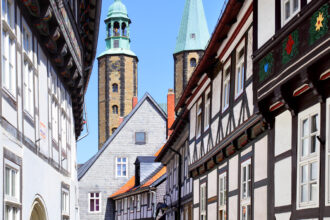In the heart of the province of North Holland lies the picturesque town of Alkmaar, known as the cheese town of the Netherlands. For more than 600 years, the world-famous cheese market has been held there on Waagplein, Alkmaar’s busiest square, from the last Friday in March to the last Friday in September, from 10 a.m. to 1 p.m. In July and August, due to the popularity of the cheese market, an additional market is held on Tuesday evenings from 7 to 9 p.m. The tradition of the cheese market dates back to 1365, when Alkmaar already had a cheese weigh house. But it was not until 1622 that the cheese carriers’ guild was founded, which marked the start of the first cheese market. At the cheese market, the cheese wheels were transported by the cheese carriers on wooden carts once they had agreed on a price. The cheese was then weighed at the cheese weighing house. These scales are located on Waagplein. The scales, the symbol of Alkmaar, date back to the 14th century and once belonged to the Holy Spirit Inn, where not only poor travelers could stay for free for three days, but also the sick were cared for. The building also housed a chapel and a cemetery. The conversion to the cheese weighing house “De Waag” was carried out in 1569 by the Bishop of Haarlem, Nicolas Nieuwland. He complied with a request from the Vroedschap (city council) dating from 1566. After the siege and successful liberation from the Spanish, William of Orange and the States of Holland transferred the weighing rights back to Alkmaar in recognition of its loyalty and piety. This is evidenced by the Latin inscription on the east side of the weighing house under the magnificent triangular gable from 1884 with its tile tableau dedicated to the Stedenmagd. It is flanked by the Roman gods Ceres and Mercury, who watch over trade and agriculture. The Latin saying reads as follows: “Senatus Populusque Alcmariensis Restitvit Virtvs Ablatae Jvra Bilancis.” This means: “Courage and strength restored the lost weighing rights to the government and citizens of Alkmaar.” These rights had been taken away from Alkmaar in 1492 due to the failed uprising of the cheese and bread people against the new taxes imposed by Count Maximilian of Austria. In 1597, the tower of the weighing house was renovated and the ridge turret was replaced by the current Waagtoren. A clock is mounted on the Waagtoren. Beneath it, in 1712, the Latin saying of the Roman poet Persius, “Vive memor leti fugit hora,” “Live in the awareness of death, time flies,” was added. The tradition of the cheese market, where 300 tons of cheese were sold every market day until 1916, and the importance of cheese for the city are commemorated by cobblestones in the shape of a piece of metal cheese with the inscription “Say Cheese Say Alkmaar.” Starting at Waagplein, these offer a 3-kilometer city tour along many of the city’s sights. Waagplein, with the city’s symbol, the weigh house, which has been a national monument since 1969, is the hotspot of Alkmaar, which I also visited on my sightseeing tour of Holland’s cheese city.



















